-

人教部编版语文八年级上册“飞天”凌空——跳水姑娘吕伟夺魁记教案
中国女子跳水五位著名运动员“跳水女皇”高敏是我国首位奥运跳板跳水金牌获得者,自1986年夺得第一个国际比赛的冠军以来,一直到1992年退役,她包揽了其间包括世界杯、世锦赛和奥运会在内的所有国际比赛的70多个世界冠军。跳水界的传奇人物伏明霞年仅14岁就成了奥运史上最年轻的冠军,被载入吉尼斯世界纪录。同时,这位板台双冠王还是我国奥运史上首位三连冠运动员。“跳水皇后”郭晶晶于1993年进入国家跳水队,2011年正式退役。她共收获了包括世界杯、奥运会、世锦赛和亚运会等在内的31个世界冠军,是世锦赛史上唯一的五连冠得主。吴敏霞在1998年入选国家跳水队,一直被认为是郭晶晶之后的我国跳水队的又一位领军人物。2016年,她收获了个人的第五枚奥运金牌,与邹凯并列我国奥运史上夺金最多的运动员。
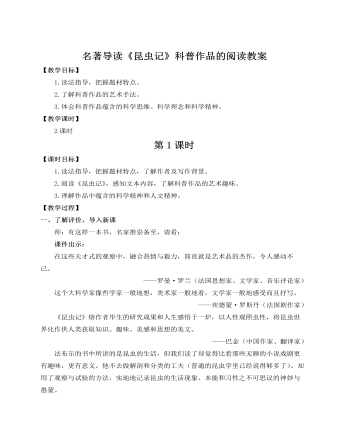
人教部编版语文八年级上册名著导读《昆虫记》 科普作品的阅读教案
整个的螳螂巢,大概可以分成三个部分。其中的一部分是由一种小片做成的,并且排列成双行,前后相互覆盖着,就好像屋顶上的瓦片一样。这种小片的边沿,有两行缺口,是用来做门路的。在小螳螂孵化的时候,就是从这个地方跑出来的。至于其他部分的墙壁,全都是不能穿过的。螳螂的卵在巢穴里面堆积成好几层。其中每一层,卵的头都是向着门口的。前面我已经提到过了,那道门有两行,分成左、右两边。所以,在这些幼虫中,有一半是从左边的门出来的,其余的则从右边的门出来。阅读感悟:作者介绍螳螂的巢时不仅对它们用的材料进行了说明,还对这两种材料做了进一步分析,而且对整个巢的构造做了详细的说明。这些正好体现出作者观察仔细、认真,乐于探究的精神。(2)法布尔科学实验的方法。综合上面两个片段,法布尔在研究昆虫时,经常采用的是观察法和实验法。课件出示:观察法可以直接用肉眼,也可以借助放大镜、显微镜等仪器,或利用照相机、录像机、摄像机等工具,有时还需要测量。
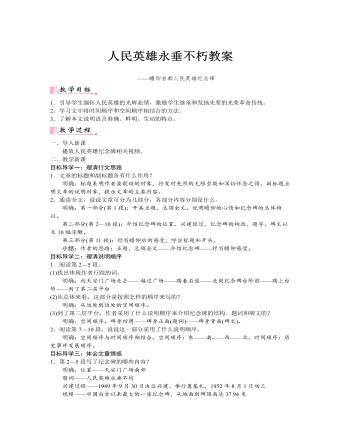
人教部编版语文八年级上册人民英雄永垂不朽教案
这篇文章的语言既有说明文语言准确、严密的特点,又有新闻特写鲜明、生动的特点,请和大家分享你最喜欢的语句,并说明理由。(学生发言)1.准确、严密示例:据地质学家化验证明,这些浮雕至少能耐800年到1000年之久。明确:“据地质学家化验证明”交代数据来源;“至少”对时间进行限定。2.鲜明、生动示例一:深夜,起义的新军和市民,摧毁了湖广总督府门前的大炮,正向总督府里冲去。总督府内熊熊的火焰冒向天空;总督府的牌子,被打断在阶前;撕碎了的清朝的龙旗,被践踏在地上。明确:“摧毁”“冲去”“冒”“打断”“撕碎”“践踏”一系列动词,准确生动地表现了起义者大无畏的革命气概,也揭示了清朝腐朽的本质。示例二:一群男女青年学生,举着“废除卖国密约”的旗帜,慷慨激昂地来到天安门前。梳着髻子、系着长裙的女学生,在向市民们散发传单。人群高处,一个男学生正在向围着他的群众演说。愤激的青年演说者,怒形于色的人群,使整个浮雕充满了痛恨卖国贼、激动人心的气氛。
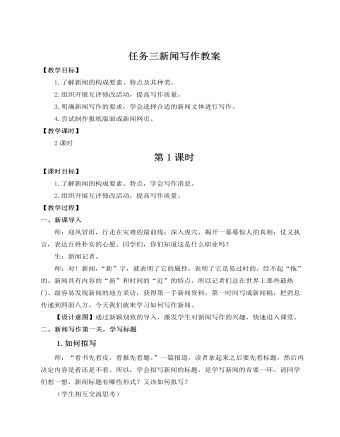
人教部编版语文八年级上册任务三新闻写作教案
五、布置作业新闻是我们了解社会、了解世界的窗口,每天都有各种各样的新闻发生。虽然新闻写作活动已经结束,但是听新闻、看新闻的活动才刚刚启幕。学了新闻写作的方法,我们再去听新闻、看新闻,就更有针对性,更能了解作者的写作意图。今天的作业比较特殊,是一个长期的作业,即希望同学们能够每天坚持至少听新闻、看新闻十分钟。结束语:同学们,明代思想家顾宪成有名联:“风声雨声读书声声声入耳;家事国事天下事事事关心。”“新闻每天发生,视角各有不同。”网络时代,我们更应该走向更广阔的世界,用一双新闻眼,发现生活中的新闻事件,传播正能量的新闻事实。这是我们的义务,也是我们光荣的责任。【设计意图】写作新闻是提升综合素质的绝佳途径之一,它让我们紧贴时代脉搏,既开阔了视野,又锻炼了思辨能力,还可以学到各种科学新知、流行文化。在学生了解了新闻写作的基本方法后,向他们提出听新闻、看新闻的要求,旨在培养他们关心时事的习惯,为他们的素养提升奠基。
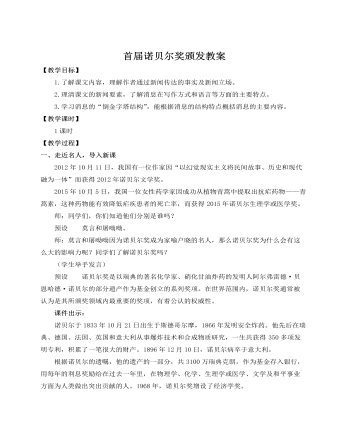
人教部编版语文八年级上册首届诺贝尔奖颁发教案
2000年,老舍先生的儿子、中国现代文学馆副馆长舒乙向外界披露了“1968年诺贝尔文学奖几乎被老舍得到”的内幕。舒乙透露,在入围者到了最后5名时还有老舍,最终,秘密投票结果的第一名就是老舍。那年,瑞典方面通过调查得知老舍已经去世,于是日本的川端康成获奖。1987、1988年诺贝尔文学奖终审名单之中,沈从文均入选,而且沈从文是1988年中最有机会获奖的候选人。诺贝尔文学奖终身评委马悦然曾透露,当时学院中有强大力量支持沈从文的候选人资格。但可惜的是,沈从文于1988年5月10日去世,因此与诺贝尔文学奖失之交臂。疑难突破《首届诺贝尔奖颁发》特别说明资金管理权和评奖权的分离,有什么用意?资金管理权和评奖权的分离能够有效保证诺贝尔奖评奖的公正性。公正性是权威性的基础,诺贝尔奖(特别是它的科技类奖项和文学奖)一百多年以来形成的权威性,与这一分离制度关系密切。就当时而言,诺贝尔奖只是首次颁发,特别需要强调其权威性。
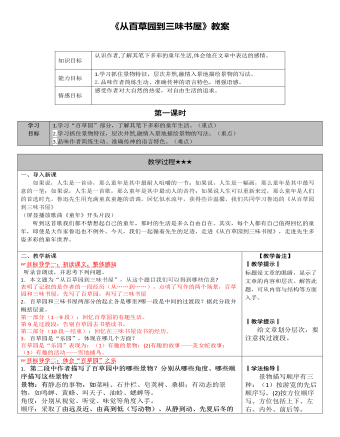
部编版语文七年级上册《从百草园到三味书屋》教案
目标导学四:拓展延伸,仿写句子1.文章描绘百草园,用了“不必说……也不必说……单是……”,把这些词语去掉读一读,跟原文对比,体会作者为什么要这样写。并试着模仿这样的句式写一段话。不必说翠绿的青山,苍劲的松柏,浮动的白云,湛蓝的天空,也不必说夜莺在婉转得歌唱,麻雀在喳喳的嬉戏,美丽的蝴蝶在风中舞动,单是一株不起眼的小草就足以令人心旷神怡,它是那么嫩绿,那么坚强,迎着凛冽的寒风昂然挺立。2.雪地捕鸟这段文字总共不到70个字,连用9个表达动作的词,把雪地捕鸟的系列活动生动而有层次的表现出来了。每句话都写得实实在在,没有可有可无的字句,试写一个游戏,表现系列动作,注意用词准确,不超过100字。他弯着腰,篮球在他的前后不停地拍着,两眼滴溜溜的转动,寻找“突围”的机会。突然他加快了脚步,一会儿左拐,一会儿右拐,冲过了两层防线,来到篮下,一个虎跳,转身投篮,篮球在空中划过一道美丽的弧线后,不偏不倚地落在筐内。
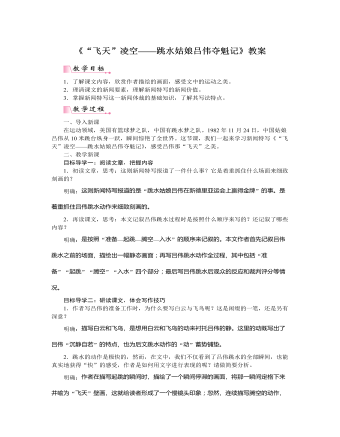
部编版语文八年级上册《“飞天凌空”——跳水姑娘吕伟夺魁记》教案
一、导入新课在运动领域,美国有篮球梦之队,中国有跳水梦之队。1982年11月24日,中国姑娘吕伟从10米跳台纵身一跃,瞬间惊艳了全世界。这节课,我们一起来学习新闻特写《“飞天”凌空——跳水姑娘吕伟夺魁记》,感受吕伟那“飞天”之美。二、教学新课目标导学一:阅读文章,把握内容1.初读文章,思考:这则新闻特写报道了一件什么事?它是着重抓住什么场面来细致刻画的?明确:这则新闻特写报道的是“跳水姑娘吕伟在新德里亚运会上赢得金牌”的事。是着重抓住吕伟跳水动作来细致刻画的。2.再读课文,思考:本文记叙吕伟跳水过程时是按照什么顺序来写的?还记叙了哪些内容?明确:是按照“准备—起跳—腾空—入水”的顺序来记叙的。本文作者首先记叙吕伟跳水之前的场面,描绘出一幅静态画面;再写吕伟跳水动作全过程,其中包括“准备”“起跳”“腾空”“入水”四个部分;最后写吕伟跳水后观众的反应和裁判评分等情况。目标导学二:研读课文,体会写作技巧
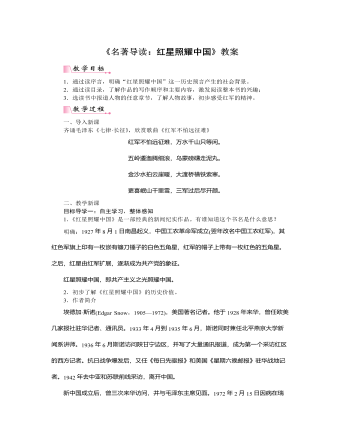
部编版语文八年级上册《名著导读:红星照耀中国》教案
读序言,可以了解内容概要、写作缘由和过程,明确写书的纲领和目的。学生活动一:用5分钟时间浏览一篇序言(译者序和作者序任挑一篇),运用跳读法采集信息点,记录在便利贴上。并互动交流。小结:序言告知我们,“红星照耀中国”是作者在中国及世界局势即将发生大转变的关键一年,冒险来到西北红色区域采访后得出的结论。那么他在苏区见到了什么,听到了什么呢?让我们把视线焦点集中到他笔下那一群“不可征服”的革命青年身上。(二)读目录,了解主要内容及写作顺序1.学生浏览目录,说一说,这本书的写作顺序是怎么样的?主要写了哪几方面的内容?【方法指导】读目录,可以对作品的内容要点和篇章结构有所了解,迅速查阅到所需要的部分。明确:《红星照耀中国》是一部文笔优美的纪实性很强的报道性作品。作者按照事件发生的自然时间顺序真实记录了自1936年6月至10月在我国西北革命根据地进行实地采访的所见所闻。该书绝大部分素材来自作者采访的第一手资料,向全世界真实报道了中国和中国工农红军以及许多红军领袖、红军将领的情况。
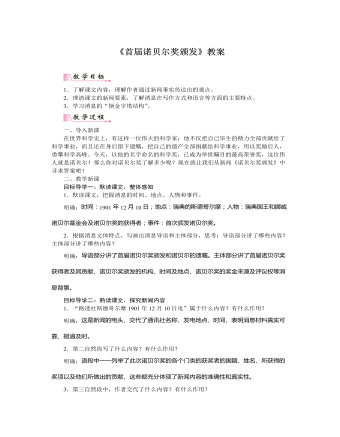
部编版语文八年级上册《首届诺贝尔奖颁发》教案
明确:导语部分讲了首届诺贝尔奖颁发和诺贝尔的遗嘱。主体部分讲了首届诺贝尔奖获得者及其贡献,诺贝尔奖颁发的机构、时间及地点,诺贝尔奖的奖金来源及评议权等消息背景。目标导学二:熟读课文,探究新闻内容1.“路透社斯德哥尔摩1901年12月10日电”属于什么内容?有什么作用?明确:这是新闻的电头,交代了通讯社名称、发电地点、时间,表明消息材料真实可靠,报道及时。2.第二自然段写了什么内容?有什么作用?明确:语段中一一列举了此次诺贝尔奖的各个门类的获奖者的国籍、姓名、所获得的奖项以及他们所做出的贡献,这些都充分体现了新闻内容的准确性和真实性。3.第三自然段中,作者交代了什么内容?有什么作用?明确:语段明确了诺贝尔奖的颁奖机构、颁奖时间和颁奖地点,使所报道的内容简洁明了,便于读者了解和掌握。
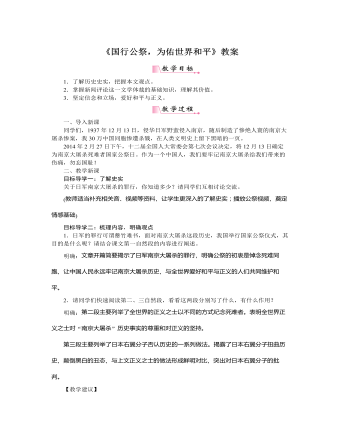
部编版语文八年级上册《国行公祭,为佑世界和平》教案
目标导学二:梳理内容,明确观点1.日军的罪行可谓罄竹难书,面对南京大屠杀这段历史,我国举行国家公祭仪式,其目的是什么呢?请结合课文第一自然段的内容进行阐述。明确:文章开篇简要揭示了日军南京大屠杀的罪行,明确公祭的初衷是悼念死难同胞,让中国人民永远牢记南京大屠杀历史,与全世界爱好和平与正义的人们共同维护和平。2.请同学们快速阅读第二、三自然段,看看这两段分别写了什么,有什么作用?明确:第二段主要列举了全世界的正义之士以不同的方式纪念死难者。表明全世界正义之士对“南京大屠杀”历史事实的尊重和对正义的坚持。第三段主要列举了日本右翼分子否认历史的一系列做法。揭露了日本右翼分子扭曲历史,颠倒黑白的丑态,与上文正义之士的做法形成鲜明对比,突出对日本右翼分子的批判。

《念奴娇·赤壁怀古》说课稿(二) 2022-2023学年统编版高中语文必修上册
读,是学生接触作品最直接的方式。初读词作,让学生听示范读,并且在课本注解的提示下,解决词作的读音问题。再进一步了解词人情况、本词的创作背景以及怀古咏史诗词的基本情况。通过齐读的方式,亲身感受词作的音韵之美。读,是放飞想象的最好方式。再读词作,通过诵读上阙内容,想象上阙描绘了一幅什么样的情景?用了哪些富有表现力的词来极力描绘这些景象?呈现出何种意境?有何作用?并且利用智慧课堂进行填空和选择。读,是把握内容的最有用的方式。通过智慧课堂随机选择,引导学生分角色诵读下阙,分析三国时的周瑜与此时的词人苏轼的形象。在对比中,感受周瑜的情场、官场、战场,场场得意的情况,和苏轼的黄州、惠州、儋州,州州失意的人生境遇。理解周瑜之于苏轼而言,是某种程度上热切向往的和难以企及的梦。读,也是赏析体悟作品主要方式。学生再次齐读下阙,赏析词作最后两句“人生如梦,一尊还酹江月”表达了作者怎样的情感?来完成本篇内容的学习。
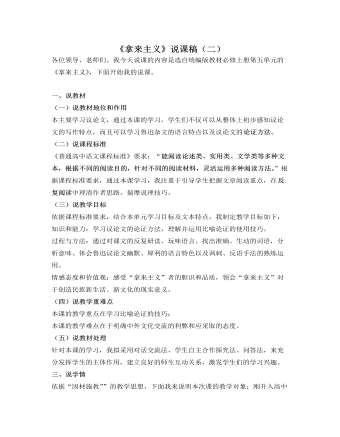
《拿来主义》说课稿(二) 2021-2022学年统编版高中语文必修上册
四、说教学过程(一)结合现实、自然导入随着我国开放的深入发展,国外的科学、文化、技术以及资产阶级的腐朽思想,生活作风等等也随之大量涌来,我们应采取怎样的态度和方法才是正确的呢?鲁迅先生在30年代就继承文化遗产问题曾写过一篇杂文,我们可以从中获得那些启示呢?(二)整体感知、疏瀹文意1.请同学介绍“我所知道的鲁迅”,教师补充写作背景。教师有针对性的进行预习检查,能促使学生养成课前预习的习惯。2.理清文章的思路,分析文章的整体结构教师范读课文,针对较难的字音进行正读。学生快速浏览课文,把握全文框架,小组讨论后分出层次。(让学生通过自主合作探究来概括文意可以让同学们参与到教学活动中,锻炼学生实际动手能力)

《荷塘月色》说课稿 (二)2021-2022学年统编版高中语文必修上册
本环节利用多媒体展示的教学手段,通过创设优美的情景来渲染气氛,引导学生接受美的熏陶,增强学生学习兴趣。教师先播放莲花的图片,让学生们谈谈自己联想到的诗词曲赋或文章,来激发学生的学习热情,随后教师总结,引出现代写荷花的名篇《荷塘月色》,从而导入新课。导语部分的设计既给了学生美感享受又自然的导入了新课。(二)初读文本,把握结构本环节主要采用了小组合作法让学生以小组合作的形式探索文章夜游顺序和情感变化这两条线索发展,教师适当的进行点拨,让学生通过探索文章线索完成对本课“圆形结构”把握。目的是发挥学生主导作用,自主学习、把握文章结构美。(三)选读文本,分析手法在本环节中主要运用讲授法和问答法。让学生反复诵读课文第4、5、6段,找出作者使用修辞手法修饰了的景物,随后师生问答作者运用了什么修辞手法来描写“荷塘”“月色”“荷花”“荷香”等景物的,又达到了什么样的效果呢?最后由教师来具体讲解本文中学生不熟悉的写作手法(如:通感)。
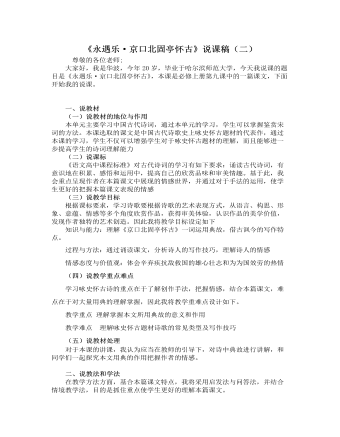
《永遇乐 · 京口北固亭怀古》说课稿(二) 2021-2022学年统编版高中语文必修上册
此环节运用的是合作探究法,采用小组讨论的形式开放回答即可。通过本课的学习,学生可以总结归纳出辛弃疾主张抗敌,收复失地的爱国热情对南宋政府苟且偏安的不满,吸取的历史教训,告诫当使用者不要草率用兵。对于决策者提出警告,抒发自己壮志难酬的感慨,教师总结归纳即可。本诗写出最大特点就是大量典故的运用。学生可以本诗对用点表达自己的看法,我将在在PPT展示诗歌用典的意义,意在帮助学生理解更好用典这种诗歌技巧。本篇是一首咏史怀古诗,本单元学习了两首同题材诗歌,有必要使学生掌握一类型的诗歌鉴赏方法。(五)比较阅读 品味历史这一环节PPT将展示上次课程学习的《念奴娇赤壁怀古》并从内容,形式等角度分析异同,采用提问的方法。此环节结束后简要归纳咏史怀古诗类型。目的是巩固加强对于咏史怀古题材诗歌理解,理解归纳咏史怀古诗题材类型。(六)布置作业 巩固感知鉴赏李白《越中览古》我将采用习题的形式,目的是使学生在实践中运用所学方法鉴赏咏史怀古诗。
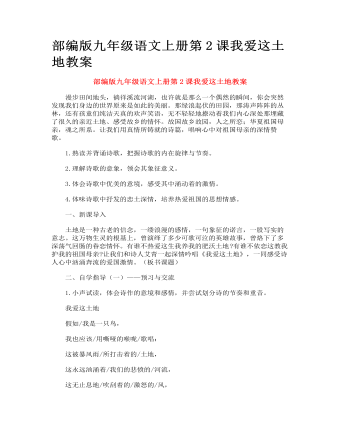
部编版九年级语文上册第2课我爱这土地教案
整体感知 齐诵诗歌,说说这首诗歌紧扣“土地”,作了哪些形象性的描述。 【交流点拨】点出土地情结。起始两句,诗人对土地的热爱,已到了不知道如何倾诉的地步,于是他舍弃人的思维语言而借用鸟的简单朴素的语言倾泻他的感情。“嘶哑”的歌声正能抒发作者对土地的义无反顾的眷恋和执着,于是土地情结的激越歌声由此响起。 倾吐土地情结。“被暴风雨所打击着的土地”“悲愤的河流”“激怒的风”“无比温柔的黎明”是作者所歌唱的对象,诗人没有沉溺于对“温柔”恬静的“黎明”的欣赏中,为了让自己的爱永远留给土地,他做出了庄严郑重的选择。 升华土地情结。一问一答,诗人由借鸟抒情转入直抒胸臆。太“深沉”太强烈的土地情结,已使人难以诉诸语言,只能凝成晶莹的泪水。“深沉”一词也许达不到与实际感情相适应的强度,于是其后紧跟着沉重的省略号。省略号中似乎涌动着潜流地火一般的激情,更为沉重地叩击着读者的心房,激起读者持续的共鸣。

新人教版高中英语必修3Unit 1 Festivals and Celebrations-Reading for writing教学设计二
Step 3 Analyzing article structureActivity 31. Teachers raise questions to guide students to analyze the chapter structure of this diary and think about how to describe the festival experience. (1)What should be included in the opening/body/closing paragraph(s)?(2)How did the writer arrange his/her ideas?(3)What kind of interesting details did the writer describe?(4)How did the writer describe his/her feelings/emotions during the event?2. Students read and compare the three sentence patterns in activity 2. Try to rewrite the first paragraph of the diary with these three sentence patterns. After that, students exchange corrections with their partners. Such as:●This was my first time spending three days experiencing the Naadam Festival in China’s Inner Mongolia Autonomous Region and it was an enjoyable and exciting experience. ●I'll never forget my experience at the Naadam Festival because it was my first time to watch the exciting Mongolian games of horse racing, wrestling, and archery so closely. ●I'll always remember my first experience at the Naadam Festival in China’s Inner Mongolia Autonomous Region because it was so amazing to spend three days witnessing a grand Mongolian ceremony. Step 4 Accumulation of statementsActivity 41. Ask the students to read the diary again. Look for sentences that express feelings and emotions, especially those with the -ing form and the past participle. Such as:● …horse racing, wrestling, and archery, which are all so exciting to watch. ● some amazing performances● I was surprised to see…● I was a little worried about. . . ● feeling really tiredOther emotional statements:●I absolutely enjoyed the archery, too, but the horse races were my favourite part. ●I'm finally back home now, feeling really tired, but celebrating Naadam with my friend was totally worth it. ●He invited me back for the winter to stay in a traditional Mongolian tent and cat hot pot. I can’t wait!2. In addition to the use of the -ing form and the past participle, the teacher should guide the students in the appreciation of these statements, ask them to memorize them, and encourage them to use them reasonably in writing practice.
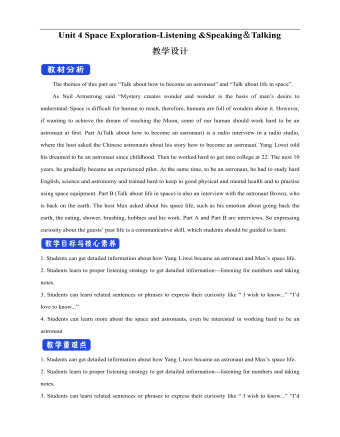
新人教版高中英语必修3Unit 4 Space Exploration-Listening&Speaking&Talking教学设计二
The themes of this part are “Talk about how to become an astronaut” and “Talk about life in space”. As Neil Armstrong said “Mystery creates wonder and wonder is the basis of man’s desire to understand. Space is difficult for human to reach, therefore, humans are full of wonders about it. However, if wanting to achieve the dream of reaching the Moon, some of our human should work hard to be an astronaut at first. Part A(Talk about how to become an astronaut) is a radio interview in a radio studio, where the host asked the Chinese astronauts about his story how to become an astronaut. Yang Liwei told his dreamed to be an astronaut since childhood. Then he worked hard to get into college at 22. The next 10 years, he gradually became an experienced pilot. At the same time, to be an astronaut, he had to study hard English, science and astronomy and trained hard to keep in good physical and mental health and to practise using space equipment. Part B (Talk about life in space) is also an interview with the astronaut Brown, who is back on the earth. The host Max asked about his space life, such as his emotion about going back the earth, the eating, shower, brushing, hobbies and his work. Part A and Part B are interviews. So expressing curiosity about the guests’ past life is a communicative skill, which students should be guided to learn.1. Students can get detailed information about how Yang Liwei became an astronaut and Max’s space life.2. Students learn to proper listening strategy to get detailed information---listening for numbers and taking notes.3. Students can learn related sentences or phrases to express their curiosity like “ I wish to know...” “I’d love to know...”4. Students can learn more about the space and astronauts, even be interested in working hard to be an astronaut
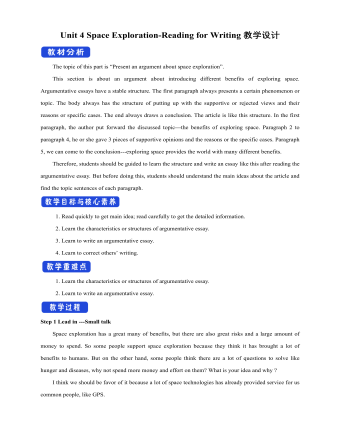
新人教版高中英语必修3Unit 4 Space Exploration-Reading for Writing教学设计二
⑦在我看来, 探索太空是值得的。As far as I am concerned, it is worthwhile to explore the space.Step 10 Writing---draftRecently, students in our class have had heated a discussion on whether space is worth exploring. Students hold different ideas about it.30% of us think space exploration is not worthwhile. They think space is too far away from us and our daily life and is a waste of money. And the money spent on space exploration can be used to solve the earth’s problems such as starvation and pollution.On the other hand,70% think space is worth exploring because we have benefited a lot from it,such as using satellites for communication and weather forecast. What’s more,with further space research,we may solve the population problem by moving to other planets one day. Also,space research will enable us to find new sources to solve the problem of energy shortages on the earth.As far as I am concerned, it is worthwhile to explore the space. Not only can it promote the development of society but also enrich our life. Step 11 Pair workExchange drafts with a partner. Use this checklist to help your partner revise his/her draft.1.Does the writer explain why he/she changed/wanted to change?2.Does the writer tell how the changes have improved or will improve his/her life?3.Is the text well-organised?4.Does the writer use words and expressions to show similarities and differences?5.Are there any grammar or spelling errors?6.Does the writer use correct punctuation?

新人教版高中英语必修3Unit 5 The value of money-Reading and Thinking教学设计二
? Could you offer me some kind of work here?? I don’t want your charity, I just want an honest job.? Careless: I landed in Britain by accident.Step 7:Consolidation.? Find Henry? Roderick and Oliver were I .making a bet when they saw Henry, a poor young man. ? Know Henry? About a month ago, Henry was sailing and later he found himself carried out to sea by a strong wind. Fortunately, he 2.was spotted by a ship. And it was the ship that brought him to 3.England? Offer money to Henry ? Oliver and Roderick gave Henry a letter and told him that there was money in it. They 4.persuaded him to accept it, and made him 5.promise that it wouldn't be opened until 2 o'clock.Step 8:Language pointsa large amount of: a large quantity of; a great deal ofe.g. They bought a large amount of furniture before they moved their new house.make a bet: make an arrangement to risk money, etc. on an event of which the result is doubtful.e.g. We made a bet on the result of the match.permit sb to do something: allow somebody to do somethinge.g. My mother doesn’t permit me to ride in the street after it rained.by accident: as a result of chancee.g. I only found it by accident.stare at: look at somebody or something with the eyes wide open in a fixed gaze( in astonishment, wonder, fear, etc)to be honest: to tell you the truth; to be franke.g. To be honest, I don’t think we have a chance of winning.Step7 Homework:What do you think will happen to Henry? Will the bank-note help him or get him into trouble?
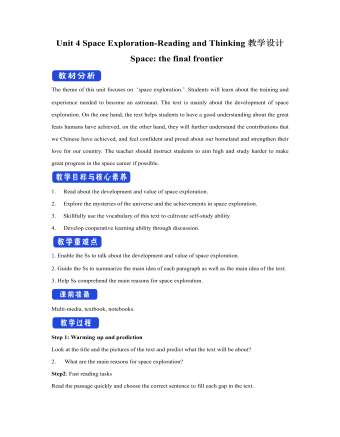
新人教版高中英语必修3Unit 4 Space Exploration-Reading and Thinking教学设计二
The theme of this unit focuses on “space exploration.” Students will learn about the training and experience needed to become an astronaut. The text is mainly about the development of space exploration. On the one hand, the text helps students to have a good understanding about the great feats humans have achieved, on the other hand, they will further understand the contributions that we Chinese have achieved, and feel confident and proud about our homeland and strengthen their love for our country. The teacher should instruct students to aim high and study harder to make great progress in the space career if possible.1. Read about the development and value of space exploration.2. Explore the mysteries of the universe and the achievements in space exploration.3. Skillfully use the vocabulary of this text to cultivate self-study ability 4. Develop cooperative learning ability through discussion.1. Enable the Ss to talk about the development and value of space exploration.2. Guide the Ss to summarize the main idea of each paragraph as well as the main idea of the text.3. Help Ss comprehend the main reasons for space exploration. Multi-media, textbook, notebooks.Step 1: Warming up and predictionLook at the title and the pictures of the text and predict what the text will be about?2. What are the main reasons for space exploration?




